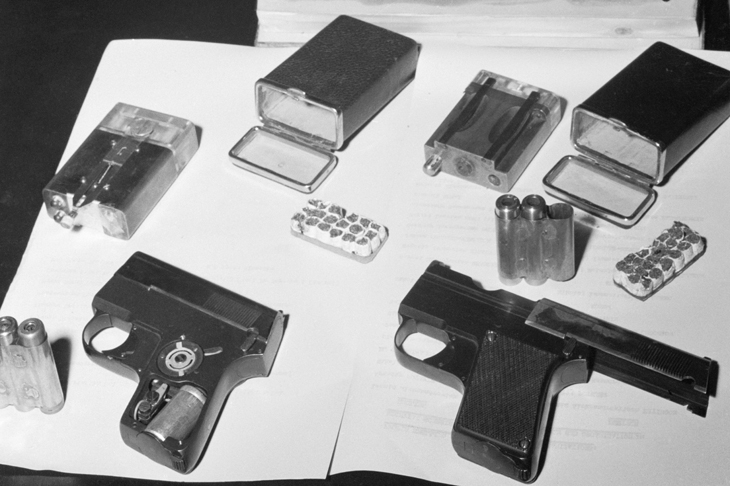As I read the last chapter of this book, news broke that the Russian ambassador to Ankara, Andrey Karlov, had been shot multiple times at close range by an off-duty Turkish police officer. Despite shocking live footage of the incident, it was unclear immediately whether this was political assassination or terrorist attack, or who was ultimately behind it. The assassin was quickly ‘neutralised’. Speaking from the Kremlin, Putin praised the slain ambassador, ordered security at Russian embassies to be stepped up, and said he wanted to know who had ‘directed’ the gunman’s hand. This is the crucial question. Not who the killer was, but for whom he was acting and with what intent.
In The Man with the Poison Gun, the assassin — Bogdan Stashinsky — is named in the prologue, where the author, Serhii Plokhy, presents the main event in rather clinical prose. Stashinsky, around whose murderous actions the book pivots, is arguably just an extension of his fascinating weapon, directed by decision-makers elsewhere. Despite some pleasing details (cyanide smuggled across borders as tinned Frankfurt sausages, a dissected brain giving off a whiff of almonds) this gives the first act of the book, Stashinsky’s recruitment, training and operations, a surprising lack of tension. With limited insight into the assassin’s character, it is hard to feel empathy when he has qualms of conscience, or engagement as he accepts his tasks against his better judgment.
Things get more gripping as doubts set in, nurtured by Stashinky’s East German girlfriend, Inge Pohl, who is unimpressed by the Soviet system. Their defection is given added excitement by the coincidence of the East-West borders closing behind them, and then the Americans refusing to believe him. But the book’s greatest set piece comes with the courtroom drama, supported by the powerful testimony quoted throughout. Some of the press at the time focused on Stashinsky’s personal narrative; the assassin ‘disarmed by love’. But as Plokhy makes clear, the real story is a political one: Soviet Russia preaching peace while organising assassinations in the West. It is here that this book comes into its own, presenting not simply a portrait of an assassin, but an assassination of a system that used political killings as an instrument of foreign policy. ‘The Soviets had lost the clandestine war of assassins and poison guns they had fought in the 1950s and 1960s,’ Plokhy argues. ‘They had been defeated in the court of public opinion.’
It is no coincidence that the title of this book suggests a Bond-style spy thriller. Throughout the story runs a fascinating subtext about just how filmic the Cold War really was. Agents of early incarnations of the KGB were trained to act out carefully staged dramas as a means to entrap potential informers; tragic graveside commemorations actually did provide crucial opportunities to identify opponents; and the poison gun itself is the most fantastic stage prop — innovative, deadly and untraceable. Before heading off on his first mission, Stashinsky and his handler drink a bottle of Soviet champagne and it makes even Stashinsky ‘think of a Russian film I had once seen’. Later, after defecting, he re-enacts his assassinations for west German agency cameras, trying to prove the veracity of his seemingly improbable stories. Ian Fleming’s The Man with the Golden Gun, written in 1964, less than two years after the trial, was clearly inspired by the Stashinsky case, and there are plenty more Bond notes throughout. Yet, as Plokhy notes, this story has as much in common with Dostoevsky and Conrad as it does Fleming. It is a story that straddles two cultures, two systems and a lot of history.
For a while Bogdan Stashinsky was a useful tool, only slightly less clever and interesting than his deadly poison gun. Before defecting, he fulfilled his tasks competently, but the murders themselves failed to achieve their political goals, and may even have ultimately damaged the regime that commissioned them, and the court system that sentenced the assassin. The Cold War may be long over, but in his epilogue Plokhy lists several more recent political assassinations, including that of the Chechen acting president Zelimkhan Yandarbiyev, killed when a bomb ripped through his car, and the attempted poisoning of Viktor Yushchenko, the pro-West Ukrainian presidential candidate, both in 2004. Aleksandr Litvinenko, poisoned in London two years later, also gets a mention, while the CIA reportedly prefer to take out their enemies using drones. ‘In this sense, the Stashinsky story is more than a piece of history,’ Plokhy writes with no false modesty. ‘It is also an insight into the present and forewarning for the future.’ With tensions once again rising, and stories such as that of Andrey Karlov still making headlines, this book makes fascinating reading.






Comments